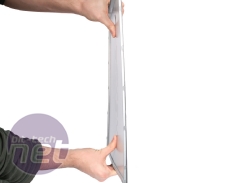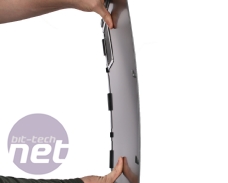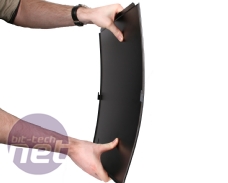
There is a one very large difference between the Fenris Wolf and the Osiris though and that’s the build materials used. While the latter used an aluminium alloy that was very hard wearing and durable, while at the same time being light and attractive, the Fenris Wolf though uses black anodised standard aluminium, with a curious almost powder coated finish.
Although this means it’s wonderfully light, looks great and is mercifully finger print free the panelling is very easy to deform or dent – almost worryingly so.
While the Hiper designed core chassis is still made from suitably thick and thus strong aluminium, all the panelling is made from thin sheet aluminium which lacks any sort of rigidity support like folded edges or support bars. This means that even feeble gamers like Joe can quite literally bend the side panels in their bare hands without too much effort, and bumping or knocking the case will result in quite obvious denting.
On the other hand, it makes them easier to work with from a modding perspective, but the problem extends to absolutely everything in the case so it doesn't look like that was the intention. Everything from the 5.25” blanking plates to the front 120mm fan mounting – it’s all too easy to noticeably dent the case and we certainly wouldn’t want to risk driving to a LAN with it in our car boot.



Click to enlarge - the difference in rigidity of a steel case panel, a reinforced aluminium panel and a Scythe Fenris Wolf side panel
We’re not too clear on the customisation on the Fenris Wolf’s panelling either. The dual thumb screws that secure the top and both side panels indicate that all three are removable – a real help when building systems. However, removing the top panel’s thumbscrews revealed that the panel was still stubbornly attached and we soon found that it had been physically glued into place. Scythe has told us that this a manufacturing fault limited to the first batch of the Fenris Wolf, and that the glue was supposed to be vibration deadening foam, which in its defence, is present on both the side panels.


Click to enlarge - the difference between a reinforced aluminium sidepanel from a Lian Li PC-9 (left) and the Fenris Wolf's (right) is clear
The glued roof panel is host to a very well cut pop out hinged hatch concealing the case’s front panel. With eSATA, dual USB 2.0 and the requisite mic and headphone ports it’s perfectly capable, although the power and reset buttons (and accompanying LEDs) are annoyingly placed behind the door. It might sound like a petty grievance, but having to open a case's door every single time you want to switch on or reset your PC will get annoying.
Opening up the meshed door reveals five meshed 5.25” drive bays, although unfortunately none are fitted with any sort of dust filter, removable or otherwise. There’s also a very welcome 5.25” to 3.5” drive bay adapter. The Fenris Wolf’s solitary 120mm intake fan is fitted at the bottom of the front fascia and is covered by a very thin mesh which should be much more capable at keeping scum out, although it’s still not as good as a dedicated, washable dust filter.
Although this means it’s wonderfully light, looks great and is mercifully finger print free the panelling is very easy to deform or dent – almost worryingly so.
While the Hiper designed core chassis is still made from suitably thick and thus strong aluminium, all the panelling is made from thin sheet aluminium which lacks any sort of rigidity support like folded edges or support bars. This means that even feeble gamers like Joe can quite literally bend the side panels in their bare hands without too much effort, and bumping or knocking the case will result in quite obvious denting.
On the other hand, it makes them easier to work with from a modding perspective, but the problem extends to absolutely everything in the case so it doesn't look like that was the intention. Everything from the 5.25” blanking plates to the front 120mm fan mounting – it’s all too easy to noticeably dent the case and we certainly wouldn’t want to risk driving to a LAN with it in our car boot.



Click to enlarge - the difference in rigidity of a steel case panel, a reinforced aluminium panel and a Scythe Fenris Wolf side panel
We’re not too clear on the customisation on the Fenris Wolf’s panelling either. The dual thumb screws that secure the top and both side panels indicate that all three are removable – a real help when building systems. However, removing the top panel’s thumbscrews revealed that the panel was still stubbornly attached and we soon found that it had been physically glued into place. Scythe has told us that this a manufacturing fault limited to the first batch of the Fenris Wolf, and that the glue was supposed to be vibration deadening foam, which in its defence, is present on both the side panels.


Click to enlarge - the difference between a reinforced aluminium sidepanel from a Lian Li PC-9 (left) and the Fenris Wolf's (right) is clear
The glued roof panel is host to a very well cut pop out hinged hatch concealing the case’s front panel. With eSATA, dual USB 2.0 and the requisite mic and headphone ports it’s perfectly capable, although the power and reset buttons (and accompanying LEDs) are annoyingly placed behind the door. It might sound like a petty grievance, but having to open a case's door every single time you want to switch on or reset your PC will get annoying.
Opening up the meshed door reveals five meshed 5.25” drive bays, although unfortunately none are fitted with any sort of dust filter, removable or otherwise. There’s also a very welcome 5.25” to 3.5” drive bay adapter. The Fenris Wolf’s solitary 120mm intake fan is fitted at the bottom of the front fascia and is covered by a very thin mesh which should be much more capable at keeping scum out, although it’s still not as good as a dedicated, washable dust filter.

MSI MPG Velox 100R Chassis Review
October 14 2021 | 15:04








Want to comment? Please log in.